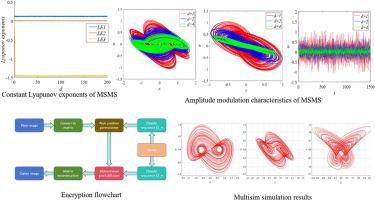改进的Shimizu-Morioka系统及其在图像加密中的应用
IF 2.5
3区 工程技术
Q3 COMPUTER SCIENCE, HARDWARE & ARCHITECTURE
引用次数: 0
摘要
本文提出了一个忆阻的Shimizu-Morioka系统(MSMS),该系统将通用压控忆阻模型集成到Shimizu-Morioka系统中。通过理论分析,阐明了参数变化对状态转换和动态特性的调节机制。结果表明,MSMS相对于记忆参数具有恒定的李雅普诺夫指数,可以实现混沌信号的灵活调幅。NIST测试证实由MSMS生成的混沌序列符合密码学标准。Multisim电路仿真验证了系统的工程可行性。此外,混沌序列成功地应用于一种新的图像加密方案,通过安全分析验证,包括密钥敏感性、统计抗攻击性、抗裁剪性、抗噪声性能和抗差分攻击。该研究将混沌理论与实际密码学应用相结合,为推进基于混沌的安全通信和加密技术提供了基础。本文章由计算机程序翻译,如有差异,请以英文原文为准。

Improved Shimizu-Morioka system and its application in image encryption
This work presents a memristive Shimizu-Morioka system (MSMS) constructed by integrating a universal voltage-controlled memristor model into the Shimizu-Morioka system. The regulatory mechanisms of parameter variations on state transitions and dynamic characteristics are elucidated through theoretical analysis. The results demonstrate that the MSMS exhibits constant Lyapunov exponents with respect to the memristive parameter, enabling flexible amplitude modulation of chaotic signals. NIST tests confirm that the chaotic sequences generated by the MSMS meet cryptographic standards. Multisim circuit simulations verify the system's engineering feasibility. Furthermore, the chaotic sequences are successfully applied to a novel image encryption scheme, validated through security analyses including key sensitivity, statistical attack resistance, anti-cropping, anti-noise performance and anti-differential attacks. This study bridges chaos theory with practical cryptographic applications, offering a foundation for advancing chaos-based secure communication and encryption technologies.
求助全文
通过发布文献求助,成功后即可免费获取论文全文。
去求助
来源期刊

Integration-The Vlsi Journal
工程技术-工程:电子与电气
CiteScore
3.80
自引率
5.30%
发文量
107
审稿时长
6 months
期刊介绍:
Integration''s aim is to cover every aspect of the VLSI area, with an emphasis on cross-fertilization between various fields of science, and the design, verification, test and applications of integrated circuits and systems, as well as closely related topics in process and device technologies. Individual issues will feature peer-reviewed tutorials and articles as well as reviews of recent publications. The intended coverage of the journal can be assessed by examining the following (non-exclusive) list of topics:
Specification methods and languages; Analog/Digital Integrated Circuits and Systems; VLSI architectures; Algorithms, methods and tools for modeling, simulation, synthesis and verification of integrated circuits and systems of any complexity; Embedded systems; High-level synthesis for VLSI systems; Logic synthesis and finite automata; Testing, design-for-test and test generation algorithms; Physical design; Formal verification; Algorithms implemented in VLSI systems; Systems engineering; Heterogeneous systems.
 求助内容:
求助内容: 应助结果提醒方式:
应助结果提醒方式:


